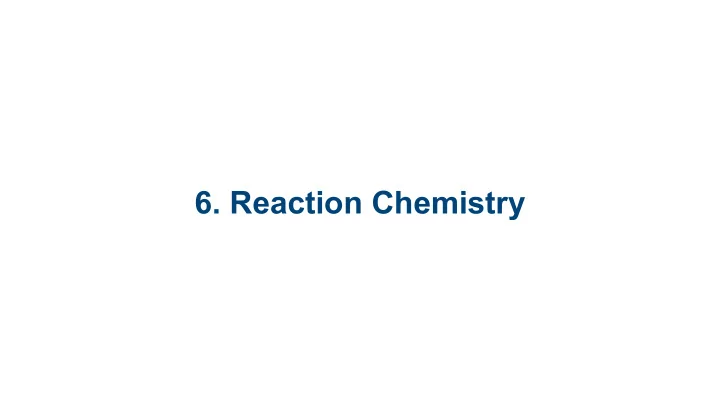

6. Reaction Chemistry
6.1 Chemical Elements 6.2 Chemical Bonding 6.3 Chemical Reactions 6.4 Thermodynamics
6.5 Properties of Water 6.6 Important Biomolecules
6.1 Chemical Elements
It is common for elements to exist as part of a larger structure. Since atoms are the building blocks of matter, we need some way of taking these pieces and building them up into larger functional structures (like people!).
H 2 O H H O H 2 O = H H O
H 2 O H H 1.008 1.008 O 16.00 What is the molecular weight of water? What is the mass % of H in a water molecule?
H 2 O H H 1.008 1.008 O 16.00 1) 1.008 + 1.008 + 16.00 = 18.016 -> 18.02 2) H x 2 = 2.016 (2.016/18.02)100 = 11.19%
6.2 Chemical Bonding
A molecule is two or more atoms held together by shared electrons – like H 2 . A compound is two or more different elemental atoms bond together through the sharing of electrons – like water!
Valence shell electrons are electrons in the outermost energy level in an atom. Atoms are most stable when their valence shell is full (8!). Atoms will exchange or share electrons in order to fill the valence shell. This is chemical bonding!
There are two common modes of bonding: Covalent, where a pair of electrons is shared and Ionic, where electrons are exchanged
6 valence e- 1 valence e- 8 is the magic number! (2 for H)
Represents 2 electrons H 2 O being shared – one from O and one from H H H O
Carbon has 4 unpaired valence shell electrons. Hydrogen has one. How many atoms of hydrogen can carbon form covalent bonds with?
Some elements pull electrons more strongly. These elements are more electronegative, and in a molecule can lead to a polar bond, like that in water.
O H 2 O (-) H H v (+) (+) H H H 2 O v O
In ionic bonding, one atom loses an electron and another takes it. The atom that loses an electron has a (+) charge and is called a cation. The atom that gains an electron has a (-) charge and is called an anion.
Na+ + Cl- A compound held together by an ionic bond is often NaCl called a salt.
7 valence e- 1 valence e- 8 is the magic number!
6.3 Chemical Reactions
Chemical reactions occur when molecules or atoms interact with each other. Reactions are symbolized with an arrow showing reaction progress from reactants to products.
There a many ways to categorize chemical reactions. We will categorize reactions using the following four reaction types: decomposition, combination, replacement, and double displacement.
A decomposition reaction often starts with a single reactant that degrades into multiple products. AB à A + B
2NaN 3 (s) 3N 2 (g) 2Na (s) +
A combination reaction often starts with multiple reactants that react to form a single product. A + B à AB
N 2 (g) 3H 2 (g) 2NH 3 (g) + Fritz Haber
A replacement reaction is when one compounds breaks apart and forms a new compound with a different reactant. AB + C à AC + B
Cu (s) 2AgNO 3 (aq) 2Ag (s) Cu(NO 3 ) 2 (aq) + +
A double replacement reaction is when two compounds break apart and exchange components to form new compounds. AB + CD à AC + BD
Pb(NO 3 ) 2 (aq) 2KI (aq) PbI 2 (s) 2KNO 3 (aq) + +
A chemical reaction can also be categorized as an oxidation or a reduction . remember LEO GER! Element Loses Electrons – Oxidation Element Gains Electrons - Reduction
6.4 Thermodynamics
Chemical reactions occur when molecules or atoms interact with each other. Reactions are symbolized with an arrow showing reaction progress from reactants to products.
?
Chemical reactions are either exothermic or endothermic. Exothermic reactions release energy. Endothermic reactions require an input of energy to proceed.
However all reactions must follow the laws of thermodynamics. 1) The law of conservation of energy and matter – matter and energy can be neither created or destroyed
2) The law of increasing disorder (entropy) – all reactions spread energy, which will tend to diminish its availability Taken together, this means that in reactions, energy and matter must always be balanced, and that reactions progress to degrade potential energy
Exothermic or endothermic?
Exothermic or endothermic?
6.5 Properties of Water
Water has a number of properties that make it a unique substance: • It is polar • It expands when frozen (solid phase is less dense than liquid phase) • High specific heat • High surface tension
Hydrogen bonding interactions … lead to high surface tension
6.6 Important Biomolecules
What makes a compound “organic”? Composed of C, H, O, and N. Important organic biomolecules: carbohydrates, lipids (fats), and proteins
Carbohydrates: “hydrates of carbon” C, H, and O Important fuel for plants and animals OH H 2 C HC O OH CH HC Glucose HC CH OH HO OH
Lipids (fats): C, H, and O (mostly C and H – non-polar!) Important for fuel storage for animals H 2 O C H 2 CH 3 C C C H 2 20-30 C O H 2 H 2 C O C H 2 HC O H 2 C C C 20-30 C H 2 H 2 H 2 C O H 2 CH 3 C C H 2 C C C H 2 H 2 20-30 O CH 3
Proteins: C, H, O, N, and sometimes S Polymers of Amino Acids Molecules like enzymes Carboxylic Acid O Amino H C NH 2 H Amino O C Acid R Structure Side Chain- highly variable!
Recommend
More recommend